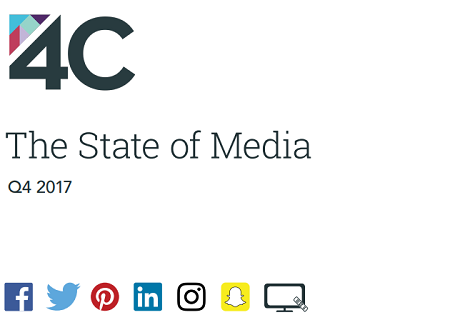Facebook is seeing a 62% YoY increase in ad spend on their platform despite current turmoil, according to new data.
New data released by marketing technology company 4C reveals spend across the major social and mobile platforms in the first quarter of 2018 increased year-over-year (YoY), with the greatest revenue growth on 4C seen by Snapchat (234%) and Instagram (136%).
Specifically, Facebook grew week-over-week during the weeks of March 17th (7%) and March 24th (15%) after the Cambridge Analytica news broke.
Key findings:
- Facebook ad spend through 4C increased 62% year-over-year in Q1 2018
- Snapchat budgets increased 234% following the redesign of its Discover page
- Advertisers leveraged digital around tentpole events like the Six Nations and Winter Games
Advertisers used digital platforms to engage audiences around large tentpole events and capture second-screen attention. The biggest UK events across the quarter were the Six Nations and Winter Games, pushing overall ad spend through 4C up 65% YoY.
To assess the state of media, 4C analysed nearly $250 million in ad spend, from a representative sample of the 1,000+ individual brands using its software platform. To gauge TV advertising trends, 4C’s Teletrax technology monitors 2100+ TV global channels, keeping track of the biggest advertisers in the UK and around the world.
Q1 2018:
- Snapchat budgets increased 234% following the redesign of its Discover page
- Advertisers used digital platforms to target audiences around large tentpole events and capture second-screen attention.
- The biggest UK events across the quarter were the Six Nations and Winter Games, pushing overall ad spend up 65% YoY.
- Brands in the consumer products sector increased quarterly spend by 78% on Twitter and 31% on Snapchat to reach their desired audience segments.
Interestingly, despite Cambridge Analytica headlines, data shows that Facebook ad spend through 4C increased 62% YoY and specifically week-over-week during the weeks of March 17th (7%) and March 24th (15%) after the news broke. This is matched both weeks by 9% increases in Instagram spending.
Aaron Goldman, CMO at 4C Insights, comments: “We’re seeing continued strength for Facebook advertising despite the negative headlines. For some time now, marketers in the UK have been actively preparing for GDPR so they are comfortable dealing with issues pertaining to data collection. In this case the main issue is not related to advertising and the repercussions such as removal of Facebook Partner Categories have not had a material impact. Targeting solutions like those offered by 4C rely on public engagement data with brand content, not user-level access, so we expect further growth.”
Marketers optimise around audiences
More and more media is being consumed simultaneously and TV audiences are commonly using second or even third screens. In response, brands are making their own shift to capitalise on this behaviour and adopting an audiences-first strategy. By using intelligence and insights to discover audiences before targeting them on the most appropriate channels, marketers in Q1 drove engagement across platforms and screens.
In the 4C Q1 State of Media report, Sachin Gadhvi VP, Growth Marketing at Cars.com comments, “We are evolving to optimise around audiences instead of channels. The organisational challenge is to use audience and performance insights to grow and optimize your spend while still maintaining channel level specialisation.”
The consumer products sector powered ad spend across Snapchat and Twitter for the first quarter of 2018. Brands from this vertical increased quarterly spend by 78% on Twitter and 31% on Snapchat to reach their desired audience segments.
“Gen-Zers are expected to account for about 40% of all consumers by 2020.” comments Carlee Benson, Media Strategy Manager at Mbuy in the 4C report, “Trends like ephemeral marketing, influencer, and short-form video are favourites amongst this generation and need to be considered with a social media strategy.”
For Snapchat this is a hugely significant trend. In November 2017 the platform debuted a new layout replacing the Discover page with sponsored content and featured celebrity stories. Content like branded Discover channels, Snap-exclusive Winter Games coverage from NBC, and the interactive Snap Map keep users engaged with the platform, helping advertisers target audiences. With Cost per Swipe Up (CPSU) increasing 13% across the quarter, this shows the increased value of the platform’s advertising inventory for brands.
The dawn of TV’s next Golden Age
Q1 saw seasonally relevant campaigns from the likes of travel brands Kayak and TUI, who invested in 3,310 minutes of ad time and 2,666 minutes respectively. However, one of the biggest ongoing media moments for the last quarter was the Six Nations rugby tournament. Spread out over six weeks the competition saw ITV sponsor, McDonald’s, rise to third place in the overall TV rankings with 4,489 ad minutes.
While ongoing campaigns throughout the quarter enabled these brands to dominate the airwaves, the greatest social lift was driven by brands that successfully jumped on the Superbowl led by T-Mobile with a 46,000% increase in social engagement during the 2 minutes following its commercials.
Goldman explains, “The 2018 Super Bowl showed marketers that television is not dying, as many have predicted, rather it is evolving into a multi-screen experience. Consumers are now empowered to enhance, share, and discuss what’s on the big screen the moment it happens. In fact, there were over 3 million social media engagements around the clubs competing and more than 1 million engagements about Justin Timberlake on the evening of the game alone. To 4C and our clients, this is evidence that TV is entering a new Golden Age. With events like the World Cup coming up this summer, brands have opportunities to connect their advertising across screens and channels and get their message to the right people, in the right place, at the right time.”
Source: www.4Cinsights.com
